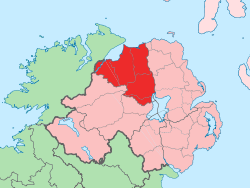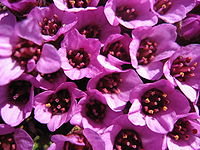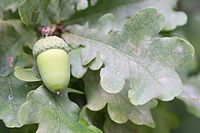- County Londonderry
-
County Londonderry / County Derry Contae Dhoire
Coontie Lunnonderrie
Coat of armsMotto: Auxilium A Domino (Latin)
"Help comes from the Lord"Country United Kingdom Region Northern Ireland Province Ulster County seat Coleraine Area – Total 800.8 sq mi (2,074 km2) Area rank 15th Population (2001) 233,500 – Rank 6th[1] Contae Dhoire[2] is the Irish name; Coontie Lunnonderrie is its name in Ulster Scots.[3] County Londonderry or County Derry is one of the six counties of Northern Ireland. Adjoined to the north-west shore of Lough Neagh, the county covers an area of 2,074 km², with a population of approximately 233,550. It is also one of the thirty-two traditional counties of Ireland, lying within the historical province of Ulster.
Since 1981 it has become one of four counties in Northern Ireland that has a Catholic majority (55.56% according to the 2001 Census[4]), with 57% of the Catholic population residing within Derry City Council.[4]
The highest point in the county is the summit of Sawel Mountain (678m) on the border with County Tyrone. Sawel is part of the Sperrin Mountains, which dominate the southern part of the county. To the east and west, the land falls into the valleys of the Bann and Foyle rivers respectively; in the south-east, the county touches the shore of Lough Neagh, which is the largest lake in Ireland; the north of the county is distinguished by the steep cliffs, dune systems and remarkable beaches of the Atlantic coast.
The county is home to a number of important buildings and landscapes, including the well-preserved 17th-century city walls of Derry; the National Trust-owned Plantation estate at Springhill; the Mussenden Temple with its spectacular views of the Atlantic; the dikes, artificial coastlines and the noted bird sanctuaries on the eastern shore of Lough Foyle; and the visitor centre at Bellaghy Bawn, close to the childhood home of Nobel laureate Seamus Heaney. In the centre of the county are the old-growth deciduous forests at Banagher and Ness Wood, where the Burntollet River flows over the highest waterfalls in Northern Ireland.
The county flower is the Purple Saxifrage.[5] The term Oak Leaf County is the county nickname particularly in relation to the county's teams in Gaelic Athletic Association competitions.
Contents
Name
Historical populations Year Pop. ±% 1659 7,102 — 1821 193,869 +2629.8% 1831 222,012 +14.5% 1841 222,174 +0.1% 1851 192,022 −13.6% 1861 184,209 −4.1% 1871 173,906 −5.6% 1881 164,991 −5.1% 1891 152,009 −7.9% 1901 144,404 −5.0% 1911 140,625 −2.6% 1926 139,693 −0.7% 1937 142,736 +2.2% 1951 155,540 +9.0% 1961 165,298 +6.3% 1966 174,658 +5.7% 1971 183,094 +4.8% 1981 197,278 +7.7% 1991 213,035 +8.0% 2001 235,864 +10.7% [6][7][8][9][10][11] The place name Derry is an anglicisation of the old Irish Daire[12] (Modern Irish Doire[13]) meaning oak-grove or oak-wood.[14] As with the city, its name is subject to the Derry/Londonderry name dispute, with the form Derry preferred by nationalists and Londonderry preferred by unionists.[15][16][17][18][19][20][21][22][23][24] The name Derry is used in the Republic of Ireland, while most of the British authorities use the name Londonderry.
History
According to the Encyclopedia of Earth, Mount Sandel in County Londonderry is "perhaps the oldest recorded settlement within Ireland".[25] Unlike the town, governmentally there was not a preceding administrative area called County Derry. Rather County Londonderry was created by James I when he gave a charter to the Irish Society to undertake the new county's plantation – the London prefix being added in reference to the London Livery Companies of the Irish Society. This charter is dated 29 March 1613,[26] and declared that the "City of Londonderry" and everything contained within:
“ shall be united, consolidated, and from hence-forth for ever be one entire County of itself, distinct and separate from all our Counties whatsoever within our Kingdom of Ireland-and from henceforth for ever be named, accounted and called, the County of Londonderry.[26]
” This new county would comprise the then County Coleraine, which consisted of the baronies of Tirkeeran, Coleraine, and Keenaght; all but the south-west corner of the barony of Loughinsholin, which was then a part of County Tyrone; the North East Liberties of Coleraine, which was part of County Antrim; and the City and Liberties of Londonderry, which were in County Donegal.[26][27] The liberties of Coleraine and Londonderry were requested by the Irish society so that they could control both banks of the mouths of the River Foyle and the River Bann and have access to sufficient wood for construction.[28]
As a result of the Local Government (Ireland) Act 1898, the city was detached from the county for administrative purposes, becoming a separate county borough from 1899. The county town of County Londonderry, and seat of the Londonderry County Council until its abolition in 1973, was therefore moved to the town of Coleraine.
Administration
In 1973 counties ceased to be a unit of administration within Northern Ireland, being replaced by district councils.
Derry City Council, Limavady Borough Council, and Magherafelt District Council all fall within County Londonderry's boundaries. Most of Coleraine Borough Council also covers an area within the county (the remainder being in County Antrim), as well as a part of Cookstown District Council (most of which covers an area in County Tyrone).
Settlements
Cities (population of 75,000 or more with a cathedral)
Large towns (population of 18,000 or more and under 75,000 at 2001 Census)[29]
Medium towns (population of 10,000 or more and under 18,000 at 2001 Census)[29]
Small towns (population of 4,500 or more and under 10,000 at 2001 Census)[29]
Intermediate settlements (population of 2,250 or more and under 4,500 at 2001 Census)[29]
- Culmore (part of Derry Urban Area), Dungiven, Eglinton, Maghera, Newbuildings (part of Derry Urban Area)
Villages (population of 1,000 or more and under 2,250 at 2001 Census)[29]
- Ballykelly, Bellaghy, Castledawson, Castlerock, Claudy, Draperstown, Garvagh, Greysteel, Kilrea, Moneymore, Strathfoyle (part of Derry Urban Area)
Small villages or hamlets (population of less than 1,000 at 2001 Census)[29]
- Articlave, Ballerin, Ballymaguigan, Ballyronan, Clady, Culnady, Desertmartin, Downhill, Drumsurn, Feeny, Gulladuff, Lettershendoney, Macosquin, Ringsend, Swatragh, Tobermore, Upperlands
Subdivisons
Baronies
- Coleraine
- Keenaght
- North East Liberties of Coleraine
- North West Liberties of Londonderry
- Loughinsholin
- Tirkeeran
Parishes
Main article: List of civil parishes of County LondonderryTownlands
Main article: List of townlands in County LondonderryEducation
Government-funded education up to secondary school level is administered by
- Western Education and Library Board: Derry, Limavady
- North Eastern Education and Library Board: Coleraine, Magherafelt
- Southern Education and Library Board: Cookstown
For Catholic grant-maintained schools administration is by the Derry Diocesan Education Office.
Two major centres of the University of Ulster are in the county, including its headquarters at Coleraine and the Magee Campus in Derry.
Sport
In Gaelic games, the Derry teams wear the colours red and white. There are many club teams competing in up to five leagues and three championships. The county team has won one All-Ireland Senior Football Championship (in 1993) and five National League titles. Hurling is also widely played but is not as popular as football.[citation needed] However, the county team is generally regarded as one of the top hurling sides in Ulster[citation needed] and in 2006 won the Nicky Rackard Cup - the third tier hurling competition in Ireland.
In association football, County Londonderry is represented in the IFA Premiership by Coleraine F.C. and Institute F.C. Coleraine are one of the most successful provincial sides in the country.[citation needed] Limavady United F.C., Moyola Park F.C., Portstewart F.C. and Tobermore United F.C. compete in the IFA Championship. Derry City F.C. play in the Premier Division of the League of Ireland after leaving the Northern Ireland structures in 1985, having resigned from the Irish Football League at the height of the Troubles because of not being allowed play their home games at the Brandywell due to security concerns from other clubs.
The Northern Ireland Milk Cup was established in 1983 and is regarded as one of the most prestigious youth football tournaments in Europe and the world.[30][31][32][33] The competition is based at Coleraine and involves several other towns and villages in the county - Limavady, Portstewart and Castlerock - and in neighbouring County Antrim - Ballymoney, Portrush, Ballymena and Broughshane. The event, held in the last week of July, has attracted teams from 56 countries around the world including Europe, the USA, Africa, the Far East, South America, the Middle East, Australia, Russia, New Zealand and Canada. Some of the biggest teams in the world have entered including Premiership giants Everton, Liverpool, Manchester United, Chelsea, Tottenham Hotspur as well as top European teams such as Feyenoord, FC Porto, FC Barcelona, Benfica, Bayern Munich and Dynamo Kiev.
In rugby union, the county is represented at senior level by Rainey Old Boys Rugby Club, Magherafelt who compete in the Ulster Senior League and All Ireland Division Three. Limavady R.F.C, City of Derry Rugby Club, Londonderry Y.M.C.A and Coleraine Rugby Club all compete in Ulster Qualifying League One.
Cricket is particularly popular in the north-west of Ireland, with 11 of the 20 senior clubs in the North West Cricket Union located in County Londonderry: Limavady, Eglinton, Glendermott, Brigade, Killymallaght, Ardmore, Coleraine, Bonds Glen, Drummond, Creevedonnell and The Nedd.
In rowing, Richard Archibald from Coleraine along with his Irish team-mates qualified for the Beijing 2008 Olympics by finishing second in the lightweight fours final in Poznan, thus qualifying for the Beijing 2008 Olympics. Another Coleraine rower Alan Campbell is a World Cup gold medallist in the single sculls in 2006.
Media
The county currently has four main radio stations
- BBC Radio Foyle
- Q102.9
- Q97.2
- Six FM (in the south of the county)
See also
- Abbeys and priories in Northern Ireland (County Londonderry)
- List of places in County Londonderry
- List of townlands in County Londonderry
- List of civil parishes of County Londonderry
- Lord Lieutenant of County Londonderry
- High Sheriff of County Londonderry
References
- ^ Key Statistics Tables 2001 Census combined for Coleraine, Derry, Limavady & Magherfelt.
- ^ "Northern Ireland". Ministry of Defence (United Kingdom). http://www.army.mod.uk/documents/general/Northern_Ireland_section_4_07.pdf. Retrieved 28 October 2010.
- ^ Banagher and Boveagh Churches Department of the Environment.
- ^ a b 2001 Census Statistics
- ^ County flowers in Britain www.plantlife.org.uk
- ^ For 1653 and 1659 figures from Civil Survey Census of those years, Paper of Mr Hardinge to Royal Irish Academy March 14, 1865.
- ^ Census for post 1821 figures.
- ^ http://www.histpop.org
- ^ http://www.nisranew.nisra.gov.uk/census
- ^ Lee, JJ (1981). "On the accuracy of the Pre-famine Irish censuses". In Goldstrom, J. M.; Clarkson, L. A.. Irish Population, Economy, and Society: Essays in Honour of the Late K. H. Connell. Oxford, England: Clarendon Press.
- ^ Mokyr, Joel; O Grada, Cormac (November). "New Developments in Irish Population History, 1700-1850". The Economic History Review 37 (4): 473–488. doi:10.1111/j.1468-0289.1984.tb00344.x. http://www3.interscience.wiley.com/journal/120035880/abstract
- ^ Delanoy, Werner et al (2007). Towards a Dialogic Anglistics. LIT Verlag. p. 38. ISBN 978-3-8258-0549-4.
- ^ http://focal.ie/Search.aspx?term=doire
- ^ Blackie, Christina (2010). Geographical Etymology. Marton Press. p. 61. ISBN 978-1445582863.
- ^ Protest at Derry name switch, The Times, January 25, 1984
- ^ Centre for European Policy Studies, accessed October 6, 2007
- ^ High Court may decide on Derry name change, The Times, May 8, 1984
- ^ "The Walled City Experience". Northern Ireland Tourist Board. http://www.discovernorthernireland.com/article.aspx?ArticleID=1588. Retrieved 2008-09-04.
- ^ BBC News: Court to Rule on City Name April 7, 2006
- ^ City name row lands in High Court BBC News
- ^ Court begins Derry name change hearing BreakingNews.ie
- ^ Judge to decide Derry name issue RTE News
- ^ Judgement of Mr Justice Weatherup
- ^ Derry City Council: Re Application for Judicial Review [2007] NIHC 5 (QB)
- ^ C.Michael Hogan. 2011. Celtic Sea. Encyclopedia of Earth. Eds. P.Saundry & C.J.Cleveland. National Council for Science and the Environment. Washington DC
- ^ a b c Notes on the Place Names of the Parishes and Townlands of the County of Londonderry, 1925, Alfred Moore Munn, Clerk of the Crown and Peace of the City and County of Londonderry
- ^ - A New History of Ireland, pages 111-112
- ^ Curl, James Stevens (2001). "The City of London and the Plantation of Ulster". BBCi History Online. http://www.bbc.co.uk/history/british/plantation/companies/londoncompanies_full.rtf. Retrieved 2008-08-10.
- ^ a b c d e f "Statistical classification of settlements". NI Neighbourhood Information Service. http://www.ninis.nisra.gov.uk/mapxtreme_towns/statistical%20classification.htm. Retrieved 23 February 2009.
- ^ Newsletter.co.uk
- ^ [1] NI Milk Cup Official Site
- ^ [2] Manchester United Official Website
- ^ University of Illinois at Chicago (UIC)
External links
Counties and cities of Northern Ireland Counties Cities Counties of Ireland Connacht Munster Leinster Ulster Italics denote non-administrative counties. Brackets denote eponymous cities or non-traditional counties. † denotes counties of Northern Ireland
Wikimedia Foundation. 2010.






